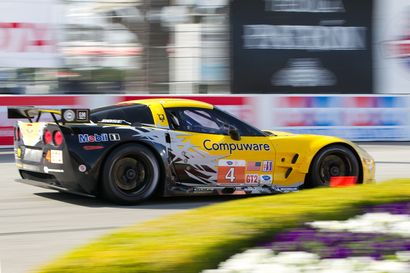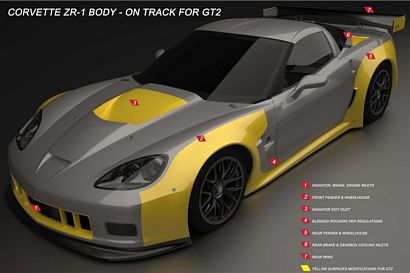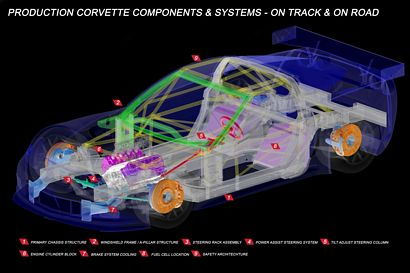The American Le Mans Series in 2010 features the second generation Corvette C6R based on the production Chevrolet Corvette ZR1

Racing update
Here at LotPro.com it seems that we’ve been a bit remiss when it comes to the latest news from Corvette Racing. So here goes:
Beginning in 2010, rules changes in the American Le Mans Series mean that Corvette Racing will now compete in the new GT category, as the series has combined the former GT1 and GT2 categories – although at Sebring as well as in the upcoming Le Mans and Petit Le Mans events it will still race in the GT2 category per ACO regulations.

Second generation C6.R
Due to restrictions regulating the GT class, rules require that many of the components found on the cars must be based on those found in the corresponding production vehicle, in this case, the Chevrolet Corvette ZR1. As such, the second-generation C6.R shares, among other things, its body design, aerodynamic package, aluminum frame/chassis structure, and steering system with the production ZR1.
[caption id="" align="aligncenter" width="410"] Shared Body Components (in yellow)[/caption]
Shared Body Components (in yellow)[/caption]
According to Chevrolet, here are some of the shared systems found on both vehicles:
Aluminum frame: The new Corvette C6.R is built on the same aluminum frame rails that underpin production Corvette Z06 and ZR1 models. Other production chassis structures in the race car include the windshield frame, the hoop around the rear of the passenger compartment, the door hinge pillars, the drivetrain tunnel, the firewall, and the floor pan.
Steering system: The new Corvette C6.R utilizes the production steering column out of the ZR1, with a fully adjustable steering wheel, and production rack-and-pinion steering rack.
Body profile: The Corvette C6.R race car is now virtually identical to the Corvette ZR1 street car in appearance, as GT rules require production-type fenders with simple flares to accommodate wider tires.
Aerodynamics: The new C6.R utilizes the full-width, production rear spoiler from the ZR1, and a production-based ZR1 front splitter that extends 25mm, in contrast to the 80mm splitter allowed under the GT1 rules. Although the aerodynamics package does not produce the same levels of downforce as the GT1 car, the C6.R is more predictable over a wide range of speeds.

Downgrading for racing
Although the natural tendency is to think that the C6.R is, if anything, more advanced than the road-going ZR1, the fact is that the restrictions placed on the GT class actually prohibit some of the production car’s more advanced components.
A case in point: while the ZR1 is equipped with carbon-composite brake rotors, GT regulations specify steel brake discs; while under the hood, the production 6.2-liter supercharged V-8 is 86’ed in favor of a naturally-aspirated small-block 5.5-liter V-8 (the maximum displacement allowed ). This engine, known as the LS5.5R, is based upon the Corvette Z06’s 7.0-liter LS7 engine and is built on production cast-aluminum cylinder blocks.
Developed, built and maintained by GM and featuring a dry-sump oiling system and titanium intake and exhaust valves, these engines are designed to use either E85R ethanol racing fuel for the ALMS series, or E10 fuel in Le Mans events.
Race results
So far this year, the results from the first two races have been promising. At Sebring, Corvette Racing’s two C6.R’s finished 8th and 9th in their class, while Long Beach produced both a 2nd place class finish (10th overall) as well as a 9th place class finish.













